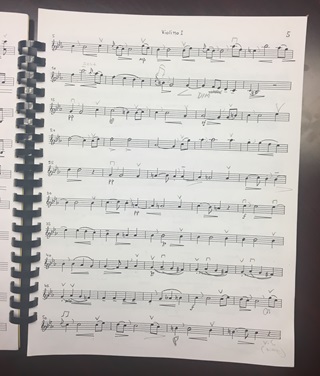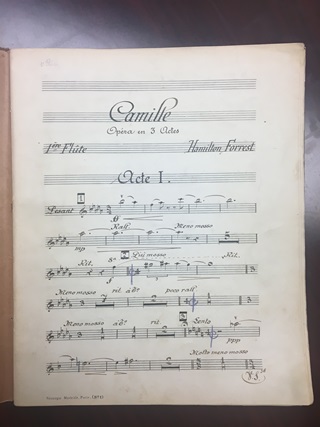April 24, 2019
Lyric Spotlight: Orchestra Member John Rosenkrans
What it Takes to be Lyric's Orchestra Librarian
Orchestra librarian John Rosenkrans has served as one of Lyric Opera of Chicago’s two librarians for the past 12 years. I had a chance to sit down and speak with him about his position here at Lyric, and also how he came to hold this highly-coveted title at one of the greatest opera companies in the world.
If, like me, you are asking yourself what a librarian’s role is at Lyric, John describes it as “the ultimate behind-the-scenes position; if I do my job correctly, no one will even know it has been done, and that is the ultimate compliment.” The only time you might see John is ten minutes before each performance, when he steps into the spotlight to put the score on the conductor’s music stand.
John highlights a common misunderstanding regarding the acquisition of music for each opera. “Many patrons might think I grab the music off the shelf and it is ready to play, but that is a misconception.” John focuses primarily on the orchestral parts and preparing those for the orchestra. It is his job to make sure that by the time the music ends up with each musician, there are no questions. John notes that “the music might not be doing what you (the conductor) want it to do in the first place.” It’s his job to manipulate the music while still maintaining its integrity.
Preparing the Scores
John works closely with the conductor and the principal string musicians to update the score with markings based on the edits they determine need to be integrated. It is John’s responsibility to then add the conductor's edits to each page of the musicians' individual parts, which is often in the hundreds. He must then make sure all string markings are transcribed in each of the string players parts. You might think it is as easy as making a digital copy of those updates, but because changes can continually be made during the rehearsal process, all markings must be made by hand in pencil so that new changes and edits can be incorporated. If the piece of music is new such as Lyric’s world premiere of Bel Canto during the 2015/16 season, John noted that he could be doing millions of markings every year for Lyric’s orchestra members.
John shared with me some examples of markings he often incorporates, which include notating new dynamic markings (when the musicians should play louder or softer, including crescendo and decrescendo markings) or indicating the direction of the bow so that the orchestra always looks uniform. John also works with the conductor to make musical cuts. For example, sections of music may be removed from an aria if they are repeated and not adding drama or any other element to the piece. Many operas even come with standard or suggested cuts, including Turandot. Another example of the use of cuts this season is in Faust, when an aria is moved forward in the opera because it is a better fit in a different location than originally composed.
A recent example of the crucial role John plays in readying the score for the musicians came during Gluck’s Orphée et Eurydice, which opened Lyric’s 2017/18 season. The music in Orphée represents the baroque style, which the Lyric Opera Orchestra does not often play. It was imperative that John pre-mark the music to note stylistic oddities that our musicians wouldn’t necessarily do out of habit, but are paramount to the baroque style of music. These agreed-upon markings are added to each musician’s score to ensure that all musicians sound uniform.

Excerpt from Orphée et Eurydice: You can see samples of the intricate markings John added to the score
Journey to Lyric
You might be asking yourself how John found his way to Lyric in this highly specialized role. John has been a musician since the age of five when he began playing the piano; at the age of 10 he began learning the bass and was exposed to a number of additional instruments throughout his childhood. In high school, John played a musical instrument every chance he could, which meant he was traveling to other high schools to play in their orchestras; John declared himself a “music nerd.”
After high school, John surprisingly chose to study computer science. His departure from music only lasted a semester; John soon realized that an undergraduate degree in double bass performance at the Eastman School of Music was more fitting for his future. John later received his Master’s Degree from the University of Wisconsin-Eau Claire in double bass performance. He then started a PhD program in musicology at University of Texas-Austin, while continuing to play double bass in the Austin Symphony.
At the age of 29, and having been a musician for nearly 25 years, John still did not fully understand what a music librarian did or that it could be a career path; but when the librarian at the Austin Symphony left, John said, “he knew he had to do it,” and left his PhD program. This was a position that would finally allow him to showcase his exposure and knowledge of a vast array of musical instruments. While there is no formal education for becoming an orchestra or opera librarian, John was lucky enough to be mentored for a year by his predecessor. John explains that orchestra and opera librarians are “first and foremost musicians, most typically coming from experience playing in orchestras. We've got to have a firm background in the operatic and symphonic repertoire, music history, music theory, and often some orchestration (how different instruments are typically composed).”
While at the Austin Symphony, John simultaneously supported the Austin Lyric Opera as their librarian where he worked on his very first opera, Faust. He later moved to Arizona where he was the librarian at both the Phoenix Symphony and Arizona Opera. John took a short hiatus from his work in the field and tuned pianos for a little over a year in Arizona.
During the summers of 1997 and 1998, John had the great fortune to serve as the orchestra librarian at the Grant Park Music Festival. It was here that John met a number of orchestra members from Lyric and felt a strong connection to them. Although John moved around a lot as a child, he always considered the Midwest home and working at Lyric Opera of Chicago as a librarian had become long-term goal of his. John’s career choice as an orchestra librarian requires a very specific skill set; and in 2005, when the orchestra librarian left Lyric, John’s opportunity to work at one of the greatest opera companies in the world became a reality. He soon began the extremely competitive interview process, and because of his robust background and experiences, he was hired for his dream job.

Excerpt from Camille: In 1929 music was still notated by hand-you can see the incredible quality of the sheet music.
Lyric Library Highlights
John has now worked as a librarian on more than 100 operas, but his favorite experience was just two years ago when he had the opportunity to work with composer Jimmy López on the world premiere of Bel Canto. After reading Ann Patchett’s bestselling novel Bel Canto, on which the opera is based, he knew it was going to be an incredible journey. John describes his experience working with Mr. Lopez: “He was remarkable in that he was 100% in what he wrote from beginning to end. Very few changes were made from his original notations.” John explains that this is a dream experience, from a librarian’s perspective.
John shared an in-depth inventory of Lyric’s current music library, and the numbers are astounding. Lyric is home to 550 opera extracts, 215 orchestral sets from different operas, 1,990 full scores, 9,400 vocal scores, and 85 reference books. John places a value of close to $2,000,000 on Lyric’s entire library. Of all of the music that can be found in Lyric’s library, John picked out what he thinks is the rarest item: an opera that was commissioned and performed by Mary Garden in 1929 titled Camille, composed by Hamilton Forrest. At the time, the piece was referred to as “the other Traviata.” Camille has never been performed again, and the score does not exist anywhere else. This is an extremely rare part of Lyric’s formidable history.
Beyond the Library
I have only begun to graze the surface of the complexities of John’s responsibilities as Lyric’s librarian; he not only supports Lyric in maintaining the standards of our orchestra’s music, but he also serves as President of MOLA, the Major Orchestra Librarians’ Association. MOLA facilitates communication between professional performance librarians, and educates and assists them in providing the highest standards of service to their organizations. It is evident that Lyric is extremely fortunate to have John as a member of our company, contributing to our mission to be one of the leading opera companies in the
